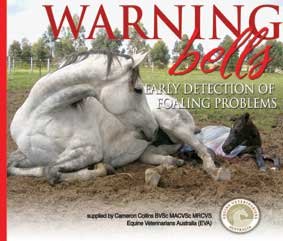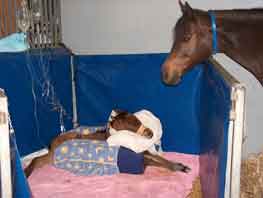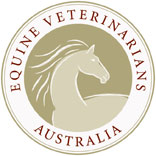|
 WARNING WARNING
BELLS
Early detection of foaling problems
Supplied by Cameron Collins
BVSc MACVSc MRCVS
Equine Veterinarians Australia
Early recognition of problem
signs during a mare's pregnancy, during the birthing process and in
the first hours of a foal's life can be the difference between a life
or death outcome.
Each foaling season, a number of newborn foals of all breeds die or
spend significant time in hospital due to neonatal illness. This is
obviously not the end result breeders hope for, given that for the best
part of a year, all possible care and attention has been lavished on
the mare carrying what, in many cases, is a highly sentimental and/or
financially valuable package. When everything goes to plan and a healthy
foal is achieved, it’s a very uplifting experience however, when
the opposite scenario occurs, it can be devastating for all involved.
Although veterinary expertise, in the form of monitoring the health
of both the mare and foal throughout the pregnancy, birthing process
and the first few days of a new life, is invaluable in identifying any
potential problems, the breeder also has an important role to play in
this process. Those experienced in the breeding industry can easily
recognise the attributes of a pregnancy that is progressing normally,
a birth that isn’t going to require human intervention, a healthy
foal and the achievement of crucial early milestones like the passing
of the placenta and commencement of suckling within a certain time frame.
These observations are certainly helpful ones for all breeders to be
aware of, as it is reassuring to know exactly what will be happening,
so when everything seems to be progressing ‘by the book’,
the whole experience becomes much more enjoyable, exciting and satisfying.
In addition to the ability to identify factors that indicate the foaling
process is going well, however, it can be of great assistance to a vet
if a breeder is also able to recognise signs that all may not be right
at the earliest possible stage. This means that issues of concern may
be able to be addressed from a number of different angles, rather than
the situation reaching a crisis point that leaves no option but for
emergency measures to be applied. Even if a breeder notices what they
perceive to be a worrying sign and seeks assistance straight away -
only to find that it didn’t turn out to be a problem after all,
that’s still a much better scenario (albeit usually a more expensive
one involving a call-out at a very uncivilised hour!) than not noticing
something until it’s too late.
Prior To Birth
One of the earliest warning signs that breeders can be instrumental
in picking up is an abnormal pregnancy length (gestation), which may
mean that a foal will be born either prematurely or after a longer period
that is considered normal (320 – 365 days, with an average of around
341 days). Careful documentation by the mare owner of the last breeding
dates, along with the results of pregnancy testing or an ultrasound
if available, should enable a close watch to be kept from approximately
the 300 day mark for signs of labour commencing. Alarm bells should
start ringing for the breeder if a mare appears to be going into labour
before 300 days of her pregnancy has elapsed, as most foals born this
premature don’t survive - even with intensive care.
When a foal’s arrival seems imminent between the 300-320 day gestation
period or it still hasn’t made an appearance after 360 days, the
most practical action a breeder can take is to prepare for the possibility
of caring for a newborn that is likely to have under-developed vital
organs and physical deficits such as muscular weakness; dropped fetlocks
(flexor tendon laxity); knee and hock deviations; a low birth weight;
a short, silky hair coat and soft, floppy ears. A suitable area, that
provides warmth, protection from the possibility of infection and is
free from factors that may contribute to either the mare or foal being
injured, needs to be set up in advance. This allows the foal to be placed
in an ideal environment without delay, providing the practitioners and
other people involved with its care with conditions to complement the
work being done to increase its chances of survival.
Newborn foals and especially premature or dysmature foals are not able
to control their body temperature, it is therefore vital that these
foals are brought into a clean, warm, dry stable with new bedding immediately
after they are born. Any time spent by a wet newborn lying in a cold,
wet paddock or in the breeze can severely drop the body temperature
and compromise the foal. These foals should be dried vigorously with
towels and covered with reflective or woolen blankets. If the weather
is very cold it may be necessary to build a wall around the foal with
hay bales and put a fan heater in with the foal, care should be taken
to avoid the possibility of fire and the heater should not be aimed
directly at the foal.
Aside from observations related to the onset of labour, other indications
of potential problems prior to foaling include a cloudy (white to yellow
or brown) discharge from the mare’s vulva and milk dripping or
running from the teats. These signs usually indicate infection and inflammation
of the placenta (placentitis) and the likelihood of a premature, late
or septic (infected) foal. If noticed early enough by the breeder, there
are measures that can be tried to curb the spread of infection and address
the inflamed placenta.
These will depend on the findings of a physical and an ultrasound examination
and may include antibiotics to combat infection, anti-inflammatory drugs
and an oral progesterone supplement to prevent the premature uterine
contractions. These treatments may be effective if instituted early,
that is when the mare first starts running milk or a vaginal discharge
is noticed, however once active labour has begun nothing can stop the
process.
During The Birth
Once the first stages of labour commence - during which contractions
start and the foal moves from its back into the normal foaling position
of the front hooves first (facing downwards), followed by the head between
the front legs - there are a number of early problem signs that the
breeder can watch for. These include severe, colic-type behaviour of
the mare, as opposed to general restlessness, frequent urination and
some degree of sweating - all of which are normal. If, however, the
mare appears to be in severe pain with violent thrashing or pawing or
getting down and up rapidly without making any obvious progress toward
delivering the foal, this can indicate twisting (torsion) of the uterus
or intestine or a uterine haemorrhage. These are serious conditions
requiring urgent veterinary treatment so, the earlier they are detected,
the better.
While waiting for the vet to arrive the breeder should attempt to stop
the mare rolling and injuring herself, this is usually best accomplished
by taking the mare to an empty grass yard or paddock and keeping her
walking.
Most breeders would be aware that the initial stages of a normal labour
- that is, the amount of time until the ‘waters’ break - can
be as little as 20 minutes or as long as several hours, depending on
the mare, so there is usually no cause for concern provided there is
not any obvious signs of intense pain and distress as would be associated
with bleeding or twisting of the uterus. What is important for breeders
to note, however, is what the fluid released when the placenta breaks
smells and looks like. If cloudy in appearance with a ‘rotten’
smell, this means it’s time to call for veterinary assistance -
as it may mean that the placenta and the foal are infected.
 Septic
foals require immediate treatment with antibiotics and usually hospitalization
with intensive care nursing, intravenous fluids and at times, intravenous
nutrition. In spite of all that is done, a number of these foals are
so compromised that they do not survive. Septic
foals require immediate treatment with antibiotics and usually hospitalization
with intensive care nursing, intravenous fluids and at times, intravenous
nutrition. In spite of all that is done, a number of these foals are
so compromised that they do not survive.
If a birth is progressing normally, a breeder would generally be expecting
to see some evidence of the waters breaking and the tips of both front
hooves starting to emerge together after a maximum of 2-3 hours - any
longer being a possible indication of abnormal positioning of the foal.
It is also important to be able to recognise the appearance of a healthy
amniotic sac (the ‘bag’ enclosing the foal) as, if this membrane
appears to be more like red velvet than white or translucent when it
first becomes visible, there can’t be any further delay in seeking
veterinary assistance. This condition, known as ‘red bag presentation’,
results in the unborn foal being deprived of oxygen, so the faulty membrane
must be ruptured and the foal delivered as a matter of urgency.
While waiting for the vet to arrive, those studs with oxygen on hand
could administer this by inserting the flexible administration tube
about five to seven centimeters up the foal’s nose and run it at
a rate of ten litres per minute.
 After
The Birth After
The Birth
Once a foal has arrived, if all the observations made by its breeder
so far have not indicated any potential problems, it isn’t time
to relax just yet - as there are many both subtle and more obvious signs
of abnormal behaviour or appearance to look for in the newborn. Some
of these relate to specific conditions with a defined set of symptoms
such as Lavendar Foal Syndrome, Neonatal Isoerythrolysis (NI) and Jaundice,
while other, more general terms such as Hypoxic-Ischaemic Syndrome (HIS)
or Neonatal Maladjustment Syndrome (NMS) refer to the consequences of
a foal being deprived of oxygen either in the uterus or during birth.
The latter are sometimes referred to as ‘dummy foals’ and
typically have difficulty standing or suckling, or may show a variety
of behaviours such as wandering from the mare, pressing their head into
the corner of a yard or box, attempting to suck walls or posts, making
abnormal vocalisations like a ‘barking’ noise (instead of
whinnying or nickering) or convulsions.
If the pregnancy and foaling progressed without problems, the most important
thing for the foal immediately after birth is that it stands and sucks
the colostrum from the mare in the first twelve hours of life. Colostrum
- the first milk the mare produces - contains the antibodies and compounds
the foal needs to establish its immune system to fight infection. A
foal can only absorb the colostrum for the first twelve to eighteen
hours after birth. So if it cannot or does not suck or if the mare does
not produce good quality colostrum or if the collostrum was lost because
the mare ran milk prior to foaling then the foal will have no defence
against infection and will require an intravenous plasma transfusion.
The best thing a breeder can do for any newborn foal is to have their
veterinarian take a blood sample for an IgG test. This test is very
straightforward and measures the level of antibodies circulating in
the bloodstream.
There are also a wealth of signs a breeder can pick up on in the first
few days of a foal’s life - many of which can become serious if
not noticed and treated, but respond well to prompt attention. The most
common include colic-type behaviour - such as the foal rising and lying
down frequently, rolling, lying on its back, straining to pass faeces
or urine - all of which can result from feeding irregularities (too
much or too little milk), retention of the meconium or impending diarrhoea.
Urine dribbling from the umbilicus (patent urachus - the stump left
after the rupture of the umbilical cord) can often indicate the presence
of a bacterial infection, while milk staining a foal’s face is
often caused by it standing under the mare’s udder, but not drinking
- a behaviour that is frequently an indication of discomfort, HIS or
impending illness.
Diarrhoea, whether caused by a bacterial infection or another factor,
is also a worrying sign that is vital for breeders not to miss as the
dehydration associated with it can result in rapid deterioration. Accompanying
diarrhoea and dehydration can be a state known as entropian, which can
be detected by closely examining the foal’s eyelids to see if the
loose skin on them is tending to turn in so the hair touches the cornea
(eyeball surface).
Yellowing of the foal’s lips and gums, if noticed by the breeder
after it has commenced suckling, is usually seen as a consequence of
the antibodies from the colostrums in the mare’s milk causing destruction
of the foal’s red blood cells - this life-threatening situation
requiring urgent veterinary attention in the form of intravenous fluids
and/or blood transfusions .
When it comes to foals, early recognition of potential problems by a
breeder with astute powers of observation, combined with the experience
and skills of a veterinarian in being able to diagnose and treat a foaling
issue promptly, are the keys to achieving the best possible outcome.
THE NORMAL FOAL AND FOALING PROCESS
The following is a summary of what are considered to be normal experiences
for a mare and her foal to have prior to the birth, during the foaling
process and afterwards;
The normal gestation (pregnancy length) for a mare is 320 – 365
days, with an average of around 341 days.
Signs of impending foaling include relaxation and slight swelling of
the mare’s vulva; occasionally small amounts of clear mucus discharge;
relaxation of the pelvic ligaments to create a sunken appearance of
the muscles on either side of the tail head; enlargement of the udder
and ‘waxing up’ (the production of white/yellow colostrum
secretion which collects on the ends of the teats). These signs can
occur between two weeks and 24 hours prior to foaling but some mares,
especially maidens, may foal without showing any.
A mare’s labour is divided into three stages.
The first stage involves the commencement of contractions of
the uterus and movement of the foal from lying on its back with its
legs curled up to lying in position for delivery - this being on its
sternum (breastbone) with its head between its outstretched front legs.
This stage ends when the placental membranes rupture and the mare ‘breaks
water’, releasing a quantity of straw coloured, urine-like fluid.
Stage Two of labour consists of the powerful, active contractions
the mare makes to deliver the foal, usually performed while lying on
her side. These contractions occur in groups of three or four, followed
by periods of two to three minutes rest - during which the mare may
rise then lie down again. The white/translucent amniotic sac should
appear at the vulva within five minutes of the water breaking, and one
or two hooves with the soles facing downward should be visible within
it. As the contractions continue, the front legs are presented, usually
one slightly in front of the other, then the head with the chin resting
on or between the knees. The amnion usually ruptures as the head and
shoulders are delivered, however if it remains over the head and nostrils,
it should be removed to prevent suffocation. The mare will often stop
straining and rest once the foal’s hips are clear of the vulva
but not usually for long, as the whole of Stage Two should only take
about 20 minutes.
The final stage of the foaling process involves expulsion of
the placenta, which should happen without obvious straining and within
30 minutes to three hours of the birth. Until it is passed, the placenta
can be tied to itself in a ball to prevent the mare standing on it -
thus tearing it before it is completely expelled - or becoming entangled.
The placenta shouldn’t be cut off, as the weight of it hanging
from the vulva assists its removal and, once completely free, should
be collected for inspection by an experienced foaling attendant or a
vet - who will determine if any intervention is required to remove part
or all of the placental tissue from the mare.
Once the foal is delivered, the mare may stand immediately or may roll
from side to side then sit up on her chest and remain quietly picking
at grass, until movement and sounds from the foal stimulate her to rise.
Normal, healthy foals should be able to sit up and hold themselves on
their chest within two to five minutes of birth, have a good sucking
reflex within 20 to 30 minutes, be able to stand within two hours and
be capable of nursing from the mare within two to four hours. Within
twelve to eighteen hours after birth foals must receive colostrum, ‘first
milk’, to provide antibodies to fight infection and glucose for
nutrition and energy. Following nursing, they should pass the meconium
(the hard, brown/yellow first faeces), urinate, lie down and sleep.
Foals that are woken should be alert and curious, standing without hesitation
and seeking the teat.
VITAL SIGNS. Within five minutes of birth, the foal’s
heart rate should be 80-120 beats per minute, respiration rate should
be 30-40 breaths per minute and lips and gums should be pale pink. Rectal
temperature should be between 37.2 and 38.6o Celsius, usually at the
lower end of this range immediately after birth and rising slowly to
plateau at about four days.
ABOUT THE AUTHOR
Cameron Collins
BVSc MACVSc MRCVS
Cameron graduated from the University of Queensland in 1991 and gained
membership of the Australia College of Veterinary Scientists in Medicine
of Horses in 1999. He is a partner in the Scone Veterinary Hospital
and a member of the Equine Veterinarians Australia (EVA) Executive.
Scone Veterinary Hospital
Contact - https://www.sconevets.com.au/
About the E.V.A.
 Equine
Veterinarians Australia (EVA) is the professional body representing
veterinarians who have a special interest in horses. Members of this
group regularly practice in the area of equine medicine, supplying veterinary
services and advice to horses and owners. Equine
Veterinarians Australia (EVA) is the professional body representing
veterinarians who have a special interest in horses. Members of this
group regularly practice in the area of equine medicine, supplying veterinary
services and advice to horses and owners.
For more information Ph (02) 9431 5080, email: administration@eva.org.au
or refer to the website www.eva.org.au |